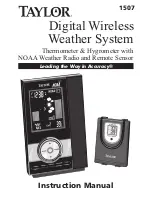
To facilitate commissioning you can initially locate the sensors in the vicinity of the base unit (at
least 6 feet or 2 m distance). In this way you can check the correct transmission of data by the
sensor.
6. Range
The free field range, i.e. the range of the line of sight contact between the transmitter and the
receiver is 300 feet or 100 m under optimum conditions. Walls and even reinforced concrete can
be penetrated, however it will reduce the range. A reduced range can have the following causes:
-
High frequency interference of all kinds
-
Buildings of all types or vegetation
-
The range of the wind sensor in particular can be affected by metal roofs or roof insulation
made from aluminum laminated glass wool.
-
The distance of the transmitter or receiver from conductive surfaces or objects (even to
the human body or the ground) has an effect on the transmission characteristics and
therefore the range.
-
Wide band interference in built up areas can reach levels that reduce the signal- noise
ratio throughout the frequency band, which reduces the range.
-
Devices working on adjacent frequencies can also affect the receiver.
-
Badly shielded PCs can radiate into the receiver and reduce the range.
7.
Repeater for range increase
Ranges that are reduced by building parameters can be compensated for by a special repeater
developed for weather stations.
The battery-driven repeater equipped with transmitter and receiver receives the data of all
sensors and re-transmits it with a slight time delay. Housed within a watertight housing the
repeater is suitable for both indoor and outdoor mounting.
8.
Maintenance and servicing information
Protect the device against dust and moisture. Never clean it with chemical cleaning materials,
use only a soft, dry linen cloth.
9. Technical
data
Measuring interval:........................................................................................... approx.3 min
Transmission frequency: ................................................................................... 433.92 MHz
Free field range:...............................................................................................max. 300 feet
Indoor temperature range: .................................................. +32ºF to +158ºF / 0ºC to +70ºC
External temperature range: ......................................... -22ºF to +158ºF / -30.0ºC to +70ºC
Resolution:........................................................................................................ 0.2ºF / 0.1ºC
Accuracy: ......................................................................................................... ±1.8ºF / ±1ºC
Measuring range relative humidity: ...................................................................... 20%- 95%
Resolution:...................................................................................................................... 1%
Accuracy: ........................................................................................................................ 8%
Air pressure measuring range: .................................. 23.62 to 32.48 inHg / 800 to 1100 hPa
Resolution:................................................................................................ 0.03 inHg / 1 hPa
Accuracy: ................................................................................................0.03 inHg / ±1 hPa
Rainfall indicator: ..................................................................... 0 to 157.4 in / 0 to 3,999 mm
Resolution: ............................................................................................< 0.02 in / < 0.5 mm
Accuracy: ...................................................................................... 2% ±0.04 in / 2 % ±1 mm
Brightness display:....................................................................................... 0 to 200000 lux
Resolution: up to 1 klux: ............. 1 lux;up to 10 klux:10 lux;up to/above 100 klux: 0.1/1 klux;
Accuracy: ........................................................................................................ ±10% ±4 Digit
Sunshine duration: ............................................................................................. 0 to 9999 h
Resolution: ...................................... up to 100 h:1 min;up to 999 h:1/10 h;above 1000 h:1 h
Wind speed: ............................................................................ 0 to 124.3 mph / 0 -200 km/h
Resolution: ...............................................................................................0.1 mph / 0.1 km/h
Accuracy: ................................................................................... 3% ±0.6 mph / 3 %±1km/h
Wind direction: ........................... graphical resolution 22.5º, numerical resolution 5 degrees
Voltage supply: ......................................................................... 4 “C” size alkaline batteries
.......................................................................................Plug-in power supply 7.5 V/500 mA
Dimensions (W x H x D): .......................... Housing: 10.1” x 8.3” x 1.4” / 257 x 211 x 36 mm
10.
Explanation of terms
Perceived temperature
-see Wind chill
Dewpoint
-Temperature point that is dependent on the conjunction of a specific air pressure, a
specific temperature and a specific humidity. At this temperature, the humidity in the air begins to
condense, the so-called dew point, the humidity in the air condenses and precipitates as a liquid
(fog, steam and even spots of mildew on walls). If the dew point for water vapor is less than 32ºF,
the condensation occurs as snow or frost.
Air pressure tendency
-Calculated from recent developments in air pressure values.
Absolute/relative air pressure
-The air in the Earth ’s atmosphere has a specific gravity, which
is defined in grams per liter. The boundary of the Earth’s atmosphere is of a (relatively) constant
size. In contrast to this, the surface of the earth including the oceans varies between the lowest
sea level and the highest mountain peaks.
As a result of this, a different “weight” of air acts on every area depending upon the mean height
above sea level and the height of the column of air above the measuring point. The air pressure
at sea level is therefore considerably higher than that in the Himalayan peaks.
In order to provide a reference quantity, in most cases, weather reports either give the absolute
air pressure referred to mean sea level (general information, say for a country) or, in the case of
more accurate reports, the graduated air pressure represented by means of isobars (the air
pressure lines on more accurate weather maps).
In the latter case, one can easily recognize the trend of the air pressure fronts and can find out
more about the path of the fronts.
However, as the weather station always measures the absolute air pressure at its location, a
correction factor must be defined, which makes it possible to display the difference between
absolute and relative air pressure. This is achieved (with this weather station) by entering the
accurately known local air pressure (either as notified by the local meteorological office or by
calculation: absolute air pressure ±0.11hPa per meter of the measuring location above/below
mean sea level).
Wind chill equivalent temperature
(perceived temperature)- A fictitious temperature, which the
human body feels under certain conditions instead of the measured temperature, and which can
be used at low temperatures (e.g. less than 45°F or 7°C) to say how comfortable one feels at
certain temperatures and wind speeds whilst wearing appropriate clothing. These conditions are
a temperature below 91.4°F (33ºC) and a wind speed higher than 5.8 mph (2.6 m/s). Wind chill is
defined as the cooling effect of uncovered skin at an assumed constant 91.4°F (33ºC) skin
surface temperature.
The higher the wind speed is and the lower the actual temperature, the more noticeable is the
wind chill effect.



































